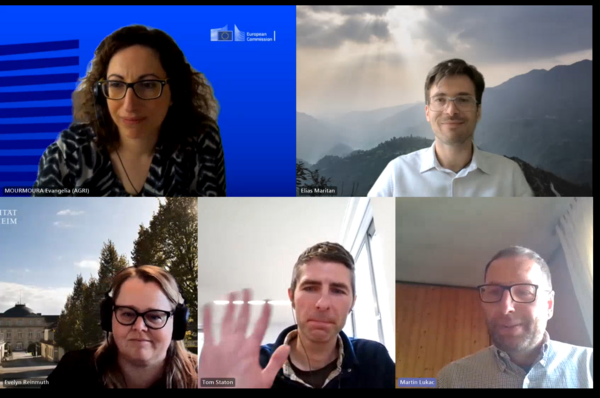On April 15th, 2025, PATH2DEA held the second and final webinar of its Digitalization Series, in collaboration with two projects from the PATH2DEA Digital Agroecology Cluster: ReForest and D4AgEcol.
Titled "Digital Tools in Agriculture: Perceptions and Barriers to Adoption," the event brought together more than 70 participants from across Europe and beyond. The webinar featured contributions from the European Commission (DG AGRI) and representatives of the participating projects, creating a rich space for exchange and shared learning.
Unlike traditional webinars, this event was designed to be interactive: attendees were invited to respond to live questions posed by the speakers, fostering engagement and allowing participants to share their own experiences with digital technologies in agriculture.
The session served as a compelling demonstration of how collaboration between projects within the PATH2DEA Digital Agroecology Cluster can foster greater synergy and added value in the transition toward sustainable agriculture.
Key Highlights from the Presentations
Moderator: Martin Lukac, coordinator of the ReForest project, guided the session.
Evangelia Mourmoura from DG AGRI, Unit on Data Governance and Digitalization, opened the discussion by underscoring the strategic importance of digitalization in the EU Commission's long-term vision for agriculture. She shared insights from the recent EU-wide farmer survey on simplification, and presented preliminary findings from a JRC-managed assessment on the current state of digitalization in EU agriculture. Her key message: while digital transformation is underway, it remains uneven, and significant barriers to adoption persist. Addressing these challenges will require coordinated efforts between technology developers, policymakers, and farming communities.
Tom Staton, from the ReForest project, offered a practical perspective on the application of digital tools in agroforestry. His presentation focused on the development and use of the FarmTree Tool and Public Goods Tool within ReForest's Living Lab network, illustrating how digital platforms can support planning, monitoring, and assessment in complex agroforestry systems.
Elias Maritan, representing D4AgEcol, presented a farmer-centered analysis of agroecologically appropriate technologies, using a multi-criteria decision-making tool to evaluate their impact on farm profitability, production costs, environmental sustainability, and human health. His talk featured four illustrative case studies: robotic weeding in German sugar beet fields, autonomous strip intercropping in UK broadacre systems, drone-based pesticide application in Greek viticulture, and virtual fencing on UK cattle grazing farms.
Evelyn Reinmuth, from the PATH2DEA team, addressed the broader question of what promotes or hinders digital tool adoption in agroecological farming. Drawing on insights from six PATH2DEA showcase workshops, she shared feedback from farmers, advisors, and producer organizations. Her presentation outlined the synergies between various types of tools, shared the perspectives of tool developers, and identified key change drivers and strategies for overcoming barriers—providing valuable guidance for stakeholders aiming to accelerate the digital transition in agroecology.
A Model for Collaboration in Sustainable Agriculture
This final webinar showcased the strength of cross-project collaboration within the PATH2DEA Digital Agroecology Cluster. By combining diverse perspectives—from policy to practice, and from tool development to field application—the event offered a well-rounded view of the current landscape of digital agriculture. It also highlighted the importance of inclusive innovation that truly reflects the needs and realities of farmers on the ground.

 tap and then scroll down to the Add to Home Screen command.
tap and then scroll down to the Add to Home Screen command.